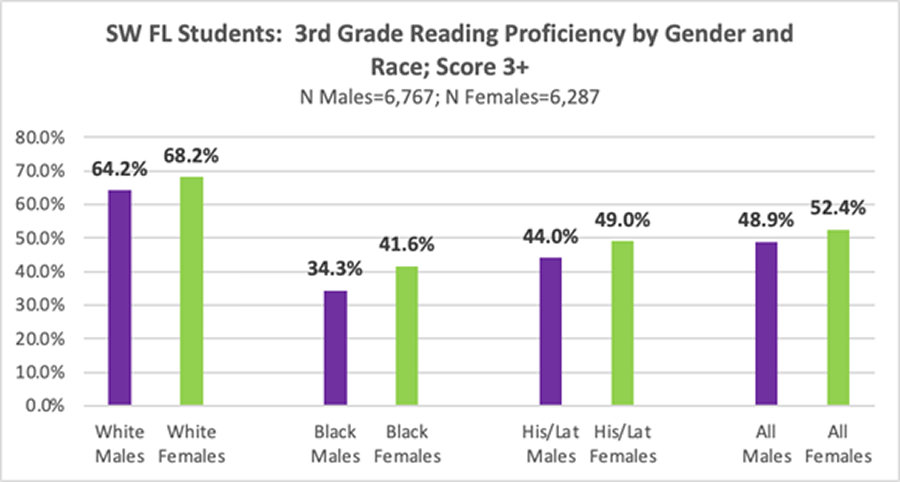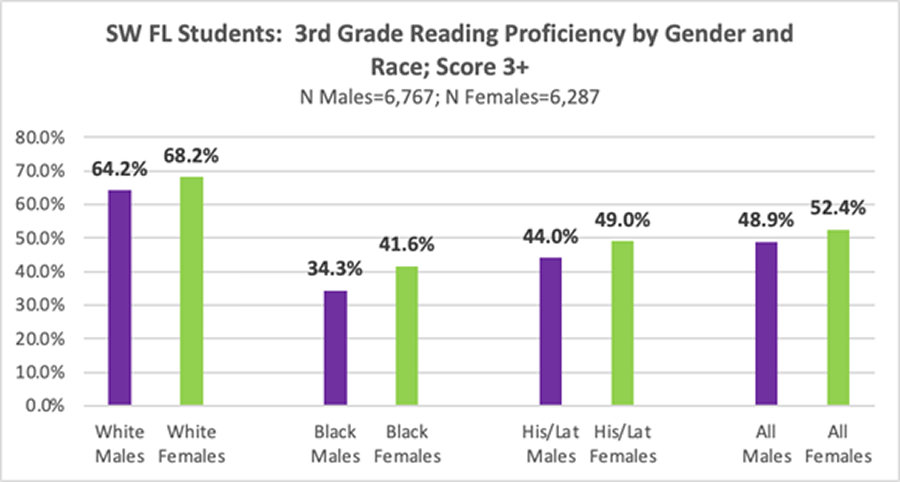
As described in the latest 2022 Educational and Workforce Outcomes Report (https://www.futuremakerscoalition.com/wp-content/uploads/2022/08/ewo2022_v1.0FINAL.pdf), high school graduation rates for male students in SW FL continue to lag behind those for female students

The inverse is also true. The drop out rate among all male students in SW FL (5.1%) is more than double those of all female students (2.3%). Drilling down into any differences among races, the drop out rates for both genders among Hispanic/Latino students in SW FL are greater than the rates for both genders among White and Black students, who have similar drop out rates

To affect meaningful system changes, the data generate several more questions. For example, what may explain the gender differences in graduation and drop out rates among the races? Why are the drop out rates for male and female Hispanic/Latino students greater than their White and Black colleagues? We can begin to explore one predictor of high school graduation as a possible clue: the ability to read at grade level by third grade. Third grade reading proficiency is the single greatest predictor of future success, because this is when children transition from learning to read to reading to learn in the fourth grade. In addition, students’ third-grade reading level relates to four educational outcomes: eighth-grade reading performance, ninth-grade course performance, high school graduation, and college attendance.

Perhaps not surprisingly if the relationship between third grade reading proficiency and high school graduation is valid, third grade reading proficiency scores of level 3 and above among male students in SW FL have also been consistently lower than those for female students over time.

Examining the data by race adds a layer of complexity. Third grade reading proficiency scores for White students outpace those for both Black and Hispanic/Latino students. Interestingly however, the reading scores for Hispanic/Latino students are greater than those for Black students, yet Hispanic/Latino
students drop out at a higher rate. A noteworthy comment from a participant at the FutureMaker’s recent Student Summit (https://www.futuremakerscoalition.com/wp-content/uploads/2022/09/2022-Student-Summit-Report-Final-1.pdf) may add some context to this observation: “In ethnic households with more children, the older siblings often take responsibility of the younger children and drop out (of school) to take care of them.”
It is important to note that two different student cohorts are represented in the data:
third grade students in 2020-21 and twelfth grade students in 2020-21. Ideally, the same cohort of students would be followed from third grade through twelfth grade to support the correlation between third grade reading proficiency and high school graduation. However, these data for a single cohort of students are not available over this nine-year period. Although the demographic make-up of the two student cohorts are similar, there may have been different environmental factors (the SW FL economy, school policies, etc.) when the twelfth graders were in the third grade nine years ago. Despite these limitations, however, the current data and the student’s anecdotal comment provide a workable hypothesis to investigate further to support of future policy, strategy, and tactical changes.



























